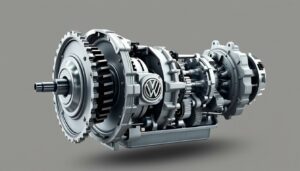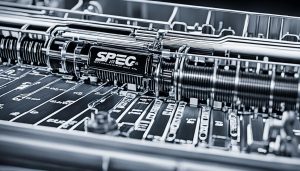Welcome to the first section of our article series on Transmissions Coolers. In this section, we will discuss the importance of Transmissions Coolers in maintaining optimal performance for your vehicle. Whether you’re a regular commuter or an adventurous off-roader, keeping your transmission cool is crucial for extended longevity and enhanced overall performance.
Transmissions Coolers play a vital role in dissipating heat generated by the transmission fluid, preventing it from reaching excessive temperature levels. This protection is essential as overheating can lead to damage and costly repairs.
An engine with steam rising off of it, set against a mountainous backdrop with cool blue hues.
By using a Transmissions Cooler, you can ensure that your transmission stays cool even under demanding conditions. This cooling effect not only improves the efficiency of your vehicle but also enhances its towing capacity and fuel economy. So, if you’re looking to maintain cool and experience peak performance, investing in a Transmissions Cooler is a smart choice.
In the upcoming sections, we will delve deeper into the essential role of Transmissions Coolers and explore the different types available in the market. We will provide valuable tips for choosing the right cooler for your vehicle and guide you through the installation process to ensure optimal performance and longevity.
Stay tuned for the next section, where we will discuss why Transmissions Coolers are essential for your vehicle.
Why Transmissions Coolers are Essential for Your Vehicle.
In this section, we will delve into the reasons why Transmissions Coolers are essential for your vehicle. We will explain how these coolers work to prevent overheating of the transmission fluid, which can lead to damage and costly repairs. Additionally, we will highlight the benefits of using Transmissions Coolers in terms of improved efficiency, increased towing capacity, and better fuel economy.
Transmissions Coolers play a vital role in maintaining the optimum operating temperature of your vehicle’s transmission system. As the transmission fluid passes through the cooler, it dissipates excessive heat generated due to friction and high operating temperatures.
Preventing Overheating and Damage
Overheating of the transmission can result in a range of issues, including damage to seals, clutch plates, and other internal components. This can lead to premature wear and tear, reduced lifespan, and the need for costly repairs or even a complete transmission replacement.
By installing a Transmissions Cooler, you effectively reduce the risk of overheating, ensuring that the transmission fluid remains at an optimal temperature. This allows for smooth operation and minimizes the chances of fluid breakdown, thus prolonging the lifespan of your transmission.
Improved Efficiency and Performance
When the transmission fluid becomes too hot, its viscosity decreases, causing it to lose its lubricating properties. This can result in increased friction and wear, negatively impacting the overall performance and efficiency of your vehicle.
With a Transmissions Cooler in place, the transmission fluid maintains its ideal viscosity, ensuring smooth gear shifts and improved power transfer. This helps preserve the performance and fuel efficiency of your vehicle, allowing it to operate at its best.
Increased Towing Capacity
If you frequently tow heavy loads with your vehicle, a Transmissions Cooler is even more crucial. Towing places additional strain on the transmission, generating more heat due to increased load and demands on the system.
A Transmissions Cooler helps in dissipating this excess heat, reducing the risk of overheating and potential damage. This allows for safer and more efficient towing, while also extending the lifespan of your transmission.
Better Fuel Economy
Overheating of the transmission not only affects performance but also impacts fuel economy. When the transmission fluid is too hot, it may cause the engine to work harder, resulting in increased fuel consumption.
By installing a Transmissions Cooler, you can maintain the optimal temperature of the transmission fluid, promoting smooth operation and minimizing unnecessary strain on the engine. This, in turn, helps improve fuel efficiency and reduce overall operating costs.
Overall, Transmissions Coolers are essential components that safeguard the health and performance of your vehicle’s transmission system. They prevent overheating, reduce the risk of damage, improve efficiency, increase towing capacity, and enhance fuel economy. Investing in a quality Transmissions Cooler is a wise decision that can save you from costly repairs and ensure the longevity of your vehicle’s transmission.
| Benefits of Transmissions Coolers: |
|---|
| Prevent overheating |
| Reduce risk of damage |
| Improve efficiency and performance |
| Increase towing capacity |
| Enhance fuel economy |
Types of Transmissions Coolers Available in the Market.
When it comes to Transmissions Coolers, there is a wide range of options available in the market. Understanding the different types of coolers can help you make an informed decision based on your specific vehicle and usage requirements. In this section, we will explore the pros and cons of each type, including air-cooled, liquid-cooled, and fan-assisted coolers.
The Types of Transmissions Coolers
1. Air-cooled Transmissions Coolers:
Air-cooled coolers utilize external airflow to cool the transmission fluid. These are the most common types of coolers and are generally more affordable. They are easy to install and maintain, making them a popular choice among vehicle owners. However, air-cooled coolers may not be as effective in extreme temperatures.
2. Liquid-cooled Transmissions Coolers:
Liquid-cooled coolers, as the name suggests, use a coolant such as water or antifreeze to regulate the transmission fluid temperature. These coolers are highly efficient and can maintain optimal temperatures even in demanding conditions. However, liquid-cooled coolers may require additional components and installation expertise, making them slightly more expensive.
3. Fan-assisted Transmissions Coolers:
Fan-assisted coolers have an integrated fan that enhances airflow and cooling efficiency. These coolers are ideal for vehicles that frequently tow heavy loads or operate in extreme conditions. The addition of a fan helps in maximizing cooling performance, ensuring consistent and reliable transmission operation. However, fan-assisted coolers may consume more power and can be bulkier compared to other types.
Comparison of Transmissions Coolers
| Type | Pros | Cons |
|---|---|---|
| Air-cooled | 1. Affordable 2. Easy to install and maintain | 1. Less effective in extreme temperatures |
| Liquid-cooled | 1. Highly efficient 2. Can maintain optimal temperatures 3. Ideal for demanding conditions | 1. More expensive 2. Requires additional components and installation expertise |
| Fan-assisted | 1. Enhanced airflow and cooling efficiency 2. Suitable for heavy loads and extreme conditions | 1. Higher power consumption 2. Bulkier compared to other types |
By considering the advantages and disadvantages of each type of Transmissions Cooler, you can select the one that best suits your vehicle’s needs. The choice depends on factors such as your budget, driving conditions, and intended usage.
Now that we have explored the various types of Transmissions Coolers available in the market, let’s move on to Section 4, where we will provide valuable tips for choosing and installing the right cooler to optimize your vehicle’s performance.
Tips for Choosing and Installing Transmissions Coolers.
When it comes to ensuring the optimal performance and longevity of your vehicle’s transmission, choosing the right Transmissions Cooler and installing it properly are crucial steps. Here are a few valuable tips to help you make the right decisions:
1. Consider Compatibility: Before purchasing a Transmissions Cooler, ensure that it is compatible with your vehicle’s make and model. Consult your vehicle’s manual or consult with a trusted mechanic to determine which cooler is the best fit for your specific transmission system.
2. Size Matters: The size of the cooler plays a significant role in its effectiveness. Make sure to choose a cooler that fits well within your vehicle’s available space without obstructing other components. Installing a cooler that is too large or too small can compromise its performance.
3. Installation Location: Choose a suitable location to install the Transmissions Cooler. Ideally, it should be placed in an area with good airflow to facilitate efficient cooling. Avoid mounting it too close to the engine or exhaust components to prevent heat transfer that could diminish its cooling capabilities.
4. Regular Maintenance: Once you have chosen and installed the Transmissions Cooler, regular maintenance is essential to keep it functioning at its best. Clean the cooler periodically to remove any debris or dirt that may obstruct airflow. Additionally, monitor the cooler’s performance and check for any signs of leaks or damage.
By following these tips, you can ensure that the Transmissions Cooler you choose is the right fit for your vehicle and that it is installed correctly. Remember that regular maintenance and monitoring are key to optimizing the performance and extending the lifespan of your Transmissions Cooler.




